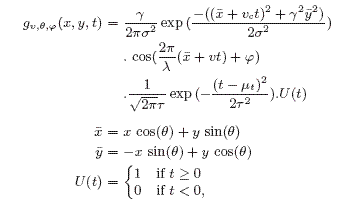
Send comments to petkov at cs dot rug dot nl or easwar at cs dot rug dot nl.
This page contains explanations concerning interactive visualisation of spatiotemporal Gabor functions.
On this site you can visualize spatiotemporal Gabor functions which model the receptive fields of motion sensitive simple cells in area V1 of the visual cortex. The receptive field function and the benefits of subsequent surround inhibition mechanisms are described in the following paper:

Essentially, gv,θ,φ(x,y,t) is a product of a Gaussian envelope function that restricts gv,θ,φ(x,y,t) in the spatial domain, a cosine wave traveling with a phase speed v in direction θ, another Gaussian function that depends only on the time t and determines the temporal decay of gv,θ,φ(x,y,t) and a step function U(t) which ensures that the filter based on gv,θ,φ(x,y,t) is causal and thereby considers inputs only from the past.
This function is used as a filter kernel by convolving it (in space and time) with an input image sequence.The phase speed v of the cosine wave is the preferred speed of the filter. In our model this speed determines the wavelength (λ) of the cosine factor and size (σ) of the receptive field (see below). Its value is specified in pixels per frame.
This angle parameter determines the preferred spatial orientation of the filter and the preferred direction of motion. For instance, when (θ = 0), a vertical edge moving rightwards will evoke higher response than edges of other orientations and directions of movement. It is specified in degrees and its range is [0,360).
The phase offset φ in the argument of the cosine factor of the Gabor function determines the symmetry of the filter in the spatial domain with respect to its (moving) center. It is specified in degrees and valid values are real numbers between -180 and 180. The values 0 and 180 correspond to center-symmetric 'center-on' and 'center-off' functions, respectively, while -90 and 90 correspond to anti-symmetric functions.
The parameter vc is the speed with which the center of the spatial Gaussian envelope moves along the x axis. When vc = 0, the center of the Gaussian envelope is stationary. This parameter has no influence on the preferred speed of the filter.
This is the wavelength of the cosine factor of the Gabor filter kernel. Given the preferred speed of the filter, the value of the wavelength is determined through the following relation
λ =
The half-response spatial frequency bandwidth b (in octaves) of a
Gabor filter is related to the ratio σ / λ, via the relation:
where σ and λ are the standard
deviation of the Gaussian factor of the Gabor function and the preferred
wavelength, respectively. The smaller the bandwidth, the larger is the
support of the Gabor function and the number of visible parallel excitatory and inhibitory stripe zones.
This parameter specifies the
ellipticity of the support of the Gabor function. For γ = 1, the support is
circular. For γ < 1 the support is elongated in orientation of the parallel
stripes of the function. Default value is γ = 0.5. This parameter refers to the mean of the temporal decay Gaussian function.
Assuming that image sequences are sampled at a video rate of 25Hz and one time unit
corresponds to 40ms, we choose μt = 1.75 to reflect the fact
that the mean time delay of the peak of the receptive field is reached about
70 ms after the stimulus onset. Mean receptive field duration (τ)
The standard deviation of the temporal Gaussian determines the mean receptive field duration. We set τ =
2.75 which corresponds to the observation that the mean duration of
most receptive fields of the concerned type is about 300 ms. 
Last changed: 2007-12-21